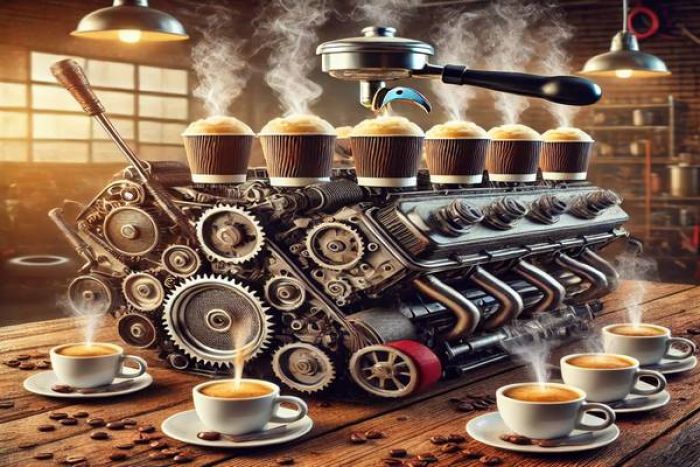The IDI engines were produced from 1983 to 1994 and were mainly used in school buses and some special equipment. Also, these engines were used in some Ford trucks and vans. Exactly trucks and vans introduced these engines to people in America. And this was one of a few diesel engines that Americans actually loved. The 7.3 IDI was pretty good, but did it have problems?
Today, we'll tell you about the IDI problems and issues that may spoil your experience with this wonderful engine. Also, we'll consider longevity and some maintenance problems for the IDI. In this article, you'll find all answers to your questions. We hope you are not going to buy anything equipped with the 7.3 IDI because it's going to be an old vehicle, but anyway, let's discuss this father of the Power Stroke series.

Key features and my opinion about the engine
- Production years:1987-1994
- Average lifespan of 7.3L IDI:450,000-500,000 miles
- Fuel supply type:indirect injection
- Power range:185-190 hp
- Fuel efficiency:awful
- Engine block material:cast-iron
- Engine reliability score:high
- The most common problems:very sensitive fuel injection system, bad fuel consumption, oil leaks, extremely poor power.
Is the 7.3 IDI actually a good diesel engine?
First of all, let's see some specs to understand what we are talking about. This is a 7.3-liter V8 diesel engine with indirect injection. The majority of the IDI engines were naturally aspirated and only in 1993 and 1994 they were turbocharged. Offering 185 horsepower and 388 lb-ft of torque, this engine wasn't the most powerful big-displacement engine on the market.
The turbocharged version offered 190 horsepower which is only 5 hp more than the naturally aspirated one. So, we can see that the turbocharger wasn't really efficient but it reduced the lifespan of the engine adding a not very reliable part to the construction.
Here are some important facts about the engine:
- the V8 diesel engine appeared to be really cool in terms of displacement, but the engineers failed to get a lot of power and torque from this displacement;
- also, the 7.3-liter diesel engine was pretty good for different types of transport, it didn't care how much the vehicle weighed;
- the engine was equipped with a 5-speed manual transmission and a 4-speed automatic one (there was also a 3-speed automatic transmission in some years);
- we would say that the engine is ideal for towing - its towing capacity is only limited by the weight that the transmission can withstand;
- it's a dull engine in terms of driving experience - it's slow and hard to rotate, also it has a low RPM limitation (red line);
- the non-turbocharged versions were pretty durable and this helped them to sell well, many of them are still on the go and ready to work hard.
Now, these engines are known to be good project engines for trucks and vans. Also, they are still working hard in some vans and trucks belonging to different companies, especially in village areas, on farms, and on ranches. Owners say a lot of good words to these engines when they write their reviews.
But what about problems? Oh, yes, 7.3 IDI engines have a lot of problems. These units come with a big pack of possible issues that keep happening during the life of the powerplants. Also, the engines are not new and some problems now happen just because they all have high mileage and standard problems for dying diesel units.
Here are some of the most common 7.3 IDI problems
Unfortunately, having some common problems is natural for all engines, old or new, diesel or gasoline, big or small. Whatever vehicle you have, you will probably have some problems with the engine if you drive the vehicle long enough. The question is when these problems start getting on your nerves and taking money out of your pocket. And this is an important factor to mention here.
The 7.3 IDI engine is not a very problematic unit, although it has some common issues. And we've studied forums and blogs to get the overall opinion about the IDI engine problems. Then, we've also spoken to some engine mechanics to ask if they agree with our list. So, we suppose, this is the most well-checked list of the 7.3 IDI problems.
Here are the most interesting ones:
- Huge power loss in mountains and high areas. Naturally aspirated diesel engines all had this problem because of air changes on the height over 10,000 ft. If you drive your 7.3 IDI in mountains, you will be confused and you'll probably think that the engine is broken.
- Fuel pump issues. Nearly all owners of the vehicles powered by the 7.3 IDI say they have repeatedly dealt with fuel pump issues. The pump can get broken because of bad fuel or just because it's time for it to get replaced. You can never predict the mileage when it can happen.
- Injector problems. Although this is a simple diesel engine with a simple injection system, it can also suffer because of bad fuel. It means you will have to pay for fixing or even replacing the fuel injectors which are not that cheap.
- Coolant leaks. Unfortunately, nearly all old engines will bother you with leaks. Coolant leaks in the 7.3 IDI are something natural. But you will have to deal with them because a low coolant level is dangerous.
- Problems with parts. Unfortunately, getting Navistar OEM parts is now very often impossible and you have to get some aftermarket parts. But if you think they are sold in every auto part shop, you are wrong. For finding a needed part, you will need to spend some time.
- Fuel mileage. Overall, these engines are not so bad and their fuel mileage is relatively good. But once something goes wrong with the injection system, the pump, the filters, or any other part of the engine and its head, the fuel mileage may become just devastating.
In our opinion, the worst problem with the 7.3 IDI is that the engine is hard to repair. Well, we don't mean that the construction is complicated. On the contrary, it's quite simple and repairable by any mechanic dealing with diesel units. But finding parts may be a huge problem.
We've seen owners of the 7.3 IDI with some major issues deciding to sell their engines to scrapyards just because they lost hope to find needed parts (high-quality ones). And this problem may not seem serious to you, but it is.
How many miles will the 7.3 IDI go?
According to our findings, the 7.3 IDI can last over 350,000 miles. If the engine is used for heavy tasks like towing and hauling, and if it is poorly maintained, it will not last that long. In these cases, the average lifespan will probably be about 200,000 miles which is still not bad at all.
But if you care about the engine, change the oil at least every 6 months of 5K miles, and you will be able to drive your vehicle much longer without any need to replace or repair the engine. This is a durable unit that can live pretty long.
What can you do to prolong the life of your 7.3 IDI?
It's a hard question because in most cases everything has been already done. These engines are not new and they all have quite a decent mileage on them. And now to give tips on how to save them from problems is not needed - they pretty much all have problems.
And still, if your 7.3 IDI diesel engine is OK now, you can follow these small tips to use it longer and spend less money on it:
- regular oil maintenance is important - bear in mind that these engines need to get an oil change more often than the majority of other engines;
- oil quality is important - buy something that suits this engine;
- don't forget about the fuel filter to clean diesel fuel your engine burns;
- don't rev up the engine and never speed your vehicle because this is not what your 7.3 IDI is made for;
- overloading the vehicle is not the best choice, also stick to the towing weight limitations;
- if you feel that the engine needs repair, just go to the shop immediately.
7.3 IDI engines don't like working when they already have some problems. You may just kill them faster and then invest thousands in them to get the engine back on track. Avoiding this is a clever idea and you can do this by maintaining the engine as it should be maintained.
Final words
We know that the 7.3 IDI diesel engine is now old and not a lot of them are left on the roads. But still, this is a legendary diesel engine made by Navistar for Ford vehicles and for some other equipment. If you own this engine, you've just got some important information on how to maintain it and how to make it do the work for a longer time with no issues and possible breakdowns.
About the authors
The CarAraC research team is composed of seasoned auto mechanics and automotive industry professionals, including individuals with advanced degrees and certifications in their field. Our team members boast prestigious credentials, reflecting their extensive knowledge and skills. These qualifications include: IMI: Institute of the Motor Industry, ASE-Certified Master Automobile Technicians; Coventry University, Graduate of MA in Automotive Journalism; Politecnico di Torino, Italy, MS Automotive Engineering; Ss. Cyril and Methodius University in Skopje, Mechanical University in Skopje; TOC Automotive College; DHA Suffa University, Department of Mechanical Engineering






Add comment